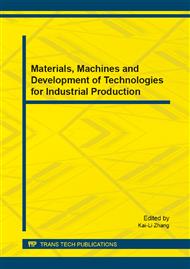[1]
Basch, E., S. Gabardi, and C. Ulbricht, Bitter melon (Momordica charantia): a review of efficacy and safety. Am J Health Syst Pharm, 2003. 60(4): pp.356-9.
DOI: 10.1093/ajhp/60.4.356
Google Scholar
[2]
Keller, A.C., et al., Saponins from the traditional medicinal plant Momordica charantia stimulate insulin secretion in vitro. Phytomedicine, 2011. 19(1): pp.32-7.
DOI: 10.1016/j.phymed.2011.06.019
Google Scholar
[3]
Shan, B., et al., Ethanol modified supercritical carbon dioxide extraction of flavonoids from Momordica charantia L. and its antioxidant activity. Food and Bioproducts Processing, 2012. 90(C3): pp.579-587.
DOI: 10.1016/j.fbp.2011.09.004
Google Scholar
[4]
Beloin, N., et al., Ethnomedicinal uses of Momordica charantia (Cucurbitaceae) in Togo and relation to its phytochemistry and biological activity. Journal of Ethnopharmacology, 2005. 96(1-2): pp.49-55.
DOI: 10.1016/j.jep.2004.08.009
Google Scholar
[5]
Mroueh, M., F. El Ghaziri, and C. Daher, Prevention of carcinogen-induced mouse skin papilloma by Daucus carota (wild carrot) aqueous extract. Planta Medica, 2011. 77(12): pp.1325-1325.
DOI: 10.1055/s-0031-1282465
Google Scholar
[6]
Chen, Q., L.L. Chan, and E.T. Li, Bitter melon (Momordica charantia) reduces adiposity, lowers serum insulin and normalizes glucose tolerance in rats fed a high fat diet. J Nutr, 2003. 133(4): pp.1088-93.
DOI: 10.1093/jn/133.4.1088
Google Scholar
[7]
Chen, P.H., et al., Bitter melon seed oil-attenuated body fat accumulation in diet-induced obese mice is associated with cAMP-dependent protein kinase activation and cell death in white adipose tissue. J Nutr, 2012. 142(7): pp.1197-204.
DOI: 10.3945/jn.112.159939
Google Scholar
[8]
Braca, A., et al., Chemical composition and antimicrobial activity of Momordica charantia seed essential oil. Fitoterapia, 2008. 79(2): pp.123-5.
DOI: 10.1016/j.fitote.2007.11.002
Google Scholar
[9]
Lang, Q. and C.M. Wai, Supercritical fluid extraction in herbal and natural product studies - a practical review. Talanta, 2001. 53(4): pp.771-82.
DOI: 10.1016/s0039-9140(00)00557-9
Google Scholar
[10]
Hauthal, W.H., Advances with supercritical fluids. Chemosphere, 2001. 43(1): pp.123-35.
Google Scholar
[11]
Chen, G.Y., et al., [Supercritical CO2 extraction and component analysis of Aesculus wilsonii seed oil]. Zhong Yao Cai, 2013. 36(3): pp.475-8.
Google Scholar
[12]
Chen, F.F., Y. Wu, and F.H. Ge, [Optimization for supercritical CO2 extraction with response surface methodology of Prunus armeniaca oil]. Zhong Yao Cai, 2012. 35(3): pp.479-82.
Google Scholar
[13]
Wu, Y., X.Y. Xiao, and F.H. Ge, [Optimization for supercritical CO2 extraction with response surface methodology and component analysis of Sapindus mukorossi oil]. Zhong Yao Cai, 2012. 35(2): pp.300-3.
Google Scholar
[14]
Wang, Y., et al., Fatty Acid Composition and Antioxidant Activity of Tea (Camellia sinensis L. ) Seed Oil Extracted by Optimized Supercritical Carbon Dioxide. Int J Mol Sci, 2011. 12(11): pp.7708-19.
DOI: 10.3390/ijms12117708
Google Scholar
[15]
Seal, C.E., I. Kranner, and H.W. Pritchard, Quantification of seed oil from species with varying oil content using supercritical fluid extraction. Phytochem Anal, 2008. 19(6): pp.493-8.
DOI: 10.1002/pca.1072
Google Scholar
[16]
Bulley, N., et al., Supercritical fluid extraction of vegetable oil seeds. Journal of the American Oil Chemists' Society, 1984. 61(8): pp.1362-1365.
DOI: 10.1007/bf02542243
Google Scholar
[17]
Zhang, S., et al., Supercritical carbon dioxide extraction of seed oil from yellow horn (Xanthoceras sorbifolia Bunge. ) and its anti-oxidant activity. Bioresour Technol, 2010. 101(7): pp.2537-44.
DOI: 10.1016/j.biortech.2009.11.082
Google Scholar
[18]
Zahedi, G. and A. Azarpour, Optimization of supercritical carbon dioxide extraction of< i> Passiflora</i> seed oil. The Journal of Supercritical Fluids, 2011. 58(1): pp.40-48.
DOI: 10.1016/j.supflu.2011.04.013
Google Scholar
[19]
Zhang, Q. -A., et al., Optimization of SC-CO< sub> 2</sub> extraction of oil from almond pretreated with autoclaving. LWT-Food Science and Technology, 2009. 42(9): pp.1530-1537.
DOI: 10.1016/j.lwt.2009.05.007
Google Scholar
[20]
Pan, W.J., et al., Supercritical Carbon Dioxide Extraction of the Oak Silkworm (Antheraea pernyi) Pupal Oil: Process Optimization and Composition Determination. Int J Mol Sci, 2012. 13(2): pp.2354-67.
DOI: 10.3390/ijms13022354
Google Scholar
[21]
Adams, R.P., Identification of essential oils by ion trap mass spectroscopy. 2012: Academic Press.
Google Scholar
[22]
Marekov, I., et al., Quantitative silver ion thin layer chromatography of triacylglycerols from sunflower oils differing in the level of linoleic acid. Journal of Liquid Chromatography & Related Technologies, 2008. 31(13): p.1959-(1968).
DOI: 10.1080/10826070802197115
Google Scholar
[23]
Nikolova-Damyanova, B., R. Velikova, and G.N. Jham, Lipid classes, fatty acid composition and triacylglycerol molecular species in crude coffee beans harvested in Brazil. Food research international, 1998. 31(6): pp.479-486.
DOI: 10.1016/s0963-9969(99)00016-2
Google Scholar
[24]
Fuchs, B., et al., Lipid analysis by thin-layer chromatography-a review of the current state. J Chromatogr A, 2011. 1218(19): pp.2754-74.
Google Scholar
[25]
Suzuki, R., et al., Occurrence of conjugated linolenic acid in flesh and seed of bitter gourd. Journal of oleo science, 2001. 50(9): pp.753-758.
DOI: 10.5650/jos.50.753
Google Scholar
[26]
Chen, P. -H., et al., Bitter melon seed oil–attenuated body fat accumulation in diet-induced obese mice is associated with cAMP-dependent protein kinase activation and cell death in white adipose tissue. The Journal of nutrition, 2012. 142(7): pp.1197-1204.
DOI: 10.3945/jn.112.159939
Google Scholar
[27]
Shanker, K.S., et al., Isolation and characterization of neutral lipids of desilked eri silkworm pupae grown on castor and tapioca leaves. J Agric Food Chem, 2006. 54(9): pp.3305-9.
DOI: 10.1021/jf060581x
Google Scholar


